Continuing with our “Definitive Guide to Terraforming“, Universe Today is happy to present our guide to terraforming Saturn’s Moons. Beyond the inner Solar System and the Jovian Moons, Saturn has numerous satellites that could be transformed. But should they be?
Around the distant gas giant Saturn lies a system of rings and moons that is unrivaled in terms of beauty. Within this system, there is also enough resources that if humanity were to harness them – i.e. if the issues of transport and infrastructure could be addressed – we would be living in an age a post-scarcity. But on top of that, many of these moons might even be suited to terraforming, where they would be transformed to accommodate human settlers.
As with the case for terraforming Jupiter’s moons, or the terrestrial planets of Mars and Venus, doing so presents many advantages and challenges. At the same time, it presents many moral and ethical dilemmas. And between all of that, terraforming Saturn’s moons would require a massive commitment in time, energy and resources, not to mention reliance on some advanced technologies (some of which haven’t been invented yet).
The Cronian Moons:
All told, Saturn system is second only to Jupiter in terms of its number of satellites, with 62 confirmed moons. Of these, the largest moons are divided into two groups: the inner large moons (those that orbit close to Saturn within its tenuous E-Ring) and the outer large moons (those beyond the E-Ring). They are, in order of distance from Saturn, Mimas, Enceladus, Tethys, Dione, Rhea, Titan, and Iapetus.
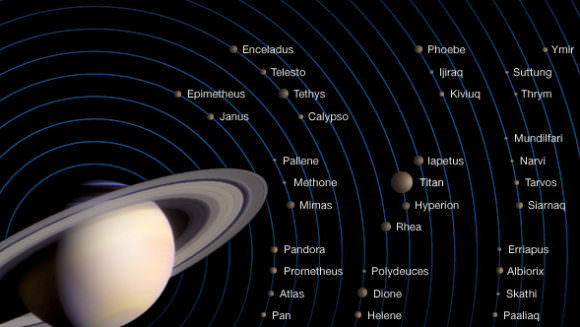
These moons are all composed primarily of water ice and rock, and are believed to be differentiated between a rocky core and an icy mantle and crust. Among them, Titan is appropriately named, being the largest and most massive of all the inner or outer moons (to the point that it is larger and more massive than all the others combined).
In terms of their suitability for human habitation, each one present its own share of pros and cons. These include their respective sizes and compositions, the presence (or absence) of an atmosphere, gravity, and the availability of water (in ice form and subsurface oceans), And in the end, it is the presence of these moons around Saturn that makes the system an attractive option for exploration and colonization.
As aerospace engineer and author Robert Zubrin stated in his book Entering Space: Creating a Spacefaring Civilization, Saturn, Uranus and Neptune could one day become “the Persian Gulf of the Solar System”, due to their abundance of hydrogen and other resources. Of these systems, Saturn would be the most important, thanks to its relative proximity to Earth, low radiation, and excellent system of moons.
Possible Methods:
Terraforming one or more of Jupiter’s moons would be a relatively straightforward process. In all cases, this would involve heating the surfaces through various means – like thermonuclear devices, impacting the surface with asteroids or comets, or focusing sunlight with orbital mirrors – to the point that surface ice would sublimate, releasing water vapor and volatiles (such as ammonia and methane) to form an atmosphere.
However, due to the comparatively low amounts of radiation coming from Saturn (compared to Jupiter), these atmospheres would have to be converted to a nitrogen-oxygen rich environment through means other than radiolysis. This could be done by using the same orbital mirrors to focus sunlight onto the surfaces, triggering the creation of oxygen and hydrogen gas from water ice through photolysis. While the oxygen would remain closer to the surface, the hydrogen would escape into space.
The presence of ammonia in many of the moon’s ices would also mean that a ready supply of nitrogen could be created to act as a buffer gas. By introducing specific strains of bacteria into the newly created atmospheres – such as the Nitrosomonas, Pseudomonas and Clostridium species – the sublimated ammonia could be converted into nitrites (NO²-) and then nitrogen gas.
Another option would be to employ a process known as “paraterraforming” – where a world is enclosed (in whole or in part) in an artificial shell in order to transform its environment. In the case of the Cronian moons, this would involve building large “Shell Worlds” to encase them, keeping the newly-created atmospheres inside long enough to effect long-term changes.
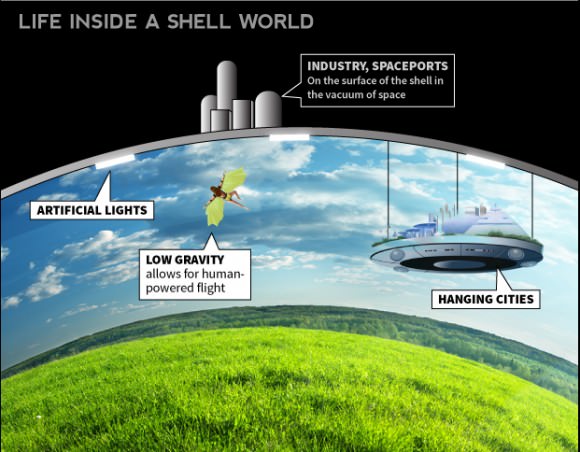
Within this shell, a Cronian moon could have its temperatures slowly raised, the water-vapor atmospheres could be exposed to ultra-violet radiation from internal UV lights, bacteria could then be introduced, and other elements added as needed. Such a shell would ensure that the process of creating of an atmosphere could be carefully controlled and none would be lost before the process was complete.
Mimas:
With a diameter of 396 km and a mass of 0.4×1020 kg, Mimas is the smallest and least massive of these moons. It is ovoid in shape and orbits Saturn at a distance of 185,539 km with an orbital period of 0.9 days. The low density of Mimas, which is estimated to be 1.15 g/cm³ (just slightly higher than that of water), indicates that it is composed mostly of water ice with only a small amount of rock.
As a result of this, Mimas is not a good candidate for terraforming. Any atmosphere that could be created by melting its ice would likely be lost to space. In addition, its low density would mean that the vast majority of the planet would be ocean, with only a small core of rock. This, in turn, makes any plans to settle on the surface impractical.
Enceladus:
Enceladus, meanwhile, has a diameter of 504 km, a mass of 1.1×1020 km and is spherical in shape. It orbits Saturn at a distance of 237,948 km and takes 1.4 days to complete a single orbit. Though it is one of the smaller spherical moons, it is the only Cronian moon that is geologically active – and one of the smallest known bodies in the Solar System where this is the case. This results in features like the famous “tiger stripes” – a series of continuous, ridged, slightly curved and roughly parallel faults within the moon’s southern polar latitudes.
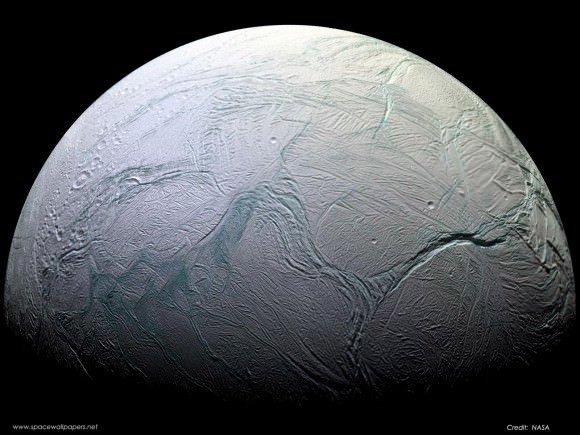
Large geysers have also been observed in the southern polar region that periodically release plumes of water ice, gas and dust which replenish Saturn’s E-ring. These jets are one of several indications that Enceladus has liquid water beneath it’s icy crust, where geothermal processes release enough heat to maintain a warm water ocean closer to its core.
The presence of a warm-water liquid ocean makes Enceladus an appealing candidate for terraforming. The composition of the plumes also indicate that the subsurface ocean is salty, and contains organic molecules and volatiles. These include ammonia and simple hydrocarbons like methane, propane, acetylene, and formaldehyde.
Ergo, once the icy surface was sublimated, these compounds would be released, triggering a natural greenhouse effect. Combined with photolysis, radiolysis, and bacteria, the water vapor and ammonia could also be converted to a nitrogen-oxygen atmosphere. The higher density of Enceladus (~1.61 g/cm3) indicates that it has a larger than average silicate and iron core (for a Cronian moon). This could provide materials for any operations on the surface, and also means that if the surface ice were to be sublimated, Enceladus would not consist mainly of incredibly deep oceans.
However, the presence of this liquid salt-water ocean, organic molecules and volatiles also indicates that the interior of Enceladus experiences hydrothermal activity. This energy source, combined with organic molecules, nutrients, and the prebiotic conditions for life, means that is possible that Enceladus is home to extraterrestrial life.
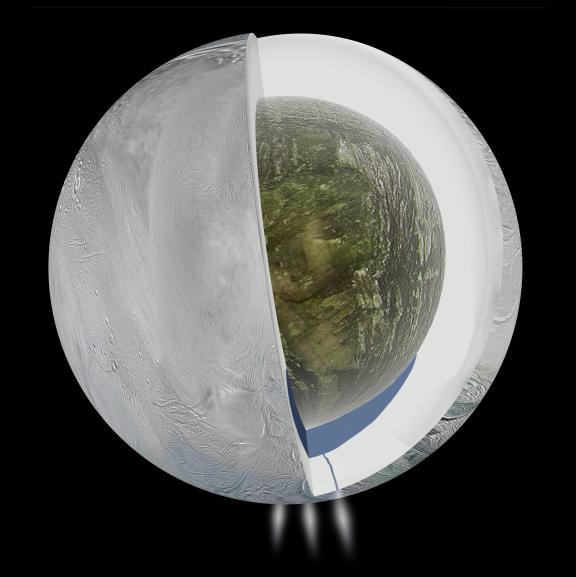
Much like Europa and Ganymede, these would probably take the form of extremophiles living in environments similar to Earth’s deep-ocean hydrothermal vents. As a result, terraforming Enceladus could result in the destruction of the natural life cycle on the moon, or release life forms that could prove harmful to any future colonists.
Tethys:
At 1066 km in diameter, Tethys is the second-largest of Saturn’s inner moons and the 16th-largest moon in the Solar System. The majority of its surface is made up of heavily cratered and hilly terrain and a smaller and smoother plains region. Its most prominent features are the large impact crater of Odysseus, which measures 400 km in diameter, and a vast canyon system named Ithaca Chasma – which is concentric with Odysseus and measures 100 km wide, 3 to 5 km deep and 2,000 km long.
With a mean density of 0.984 ± 0.003 grams per cubic centimeter, Tethys is believed to be comprised almost entirely of water ice. It is not currently known whether Tethys is differentiated into a rocky core and ice mantle. However, given the fact that rock accounts for less 6% of its mass, a differentiated Tethys would have a core that did not exceed 145 km in radius. On the other hand, Tethys’ shape – which resembles that of a triaxial ellipsoid – is consistent with it having a homogeneous interior (i.e. a mix of ice and rock).
Because of this, Tethys is also off the terraforming list. If in fact it has a tiny rocky interior, treating the surface to heating would mean that the vast majority of the moon would melt and be lost to space. Alternately, if the interior is a homogeneous mix of rock and ice, then all that would remain after melting occurred would be a cloud of debris.
Dione:
With a diameter and mass of 1,123 km and 11×1020 kg, Dione is the fourth largest moon of Saturn. The majority of Dione’s surface is heavily cratered old terrain, with craters that measure up to 250 km in diameter. With an orbital distance of 377,396 km from Saturn, the moon takes 2.7 days to complete a single rotation.
Dione’s mean density of about 1.478 g/cm³ indicates that it is composed mainly of water ice, with a small remainder likely consisting of a silicate rock core. Dione also has a very thin atmosphere of oxygen ions (O+²), which was first detected by the Cassini space probe in 2010. While the source of this atmosphere is currently unknown, it is believed that it is the product of radiolysis, where charged particles from Saturn’s radiation belt interact with water ice on the surface to create hydrogen and oxygen (similar to what happens on Europa).
Because of this tenuous atmosphere, it is already known that sublimating Dione’s ice could produce an oxygen atmosphere. However, it is not currently known if Dione possesses the right combination of volatilizes to ensure that nitrogen gas can be created, or that a greenhouse effect will be triggered. Combined with Dione’s low density, this makes it an unattractive target for terraforming.
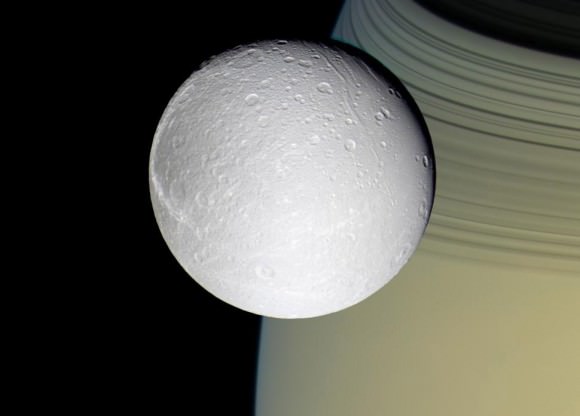
Rhea:
Measuring 1,527 km in diameter and 23×1020 kg in mass, Rhea is the second largest of Saturn’s moons and the ninth largest moon of the Solar System. With an orbital radius of 527,108 km, it is the fifth-most distant of the larger moons, and takes 4.5 days to complete an orbit. Like other Cronian satellites, Rhea has a rather heavily cratered surface, and a few large fractures on its trailing hemisphere.
With a mean density of about 1.236 g/cm³, Rhea is estimated to be composed of 75% water ice (with a density of roughly 0.93 g/cm³) and 25% of silicate rock (with a density of around 3.25 g/cm³). This low density means that although Rhea is the ninth-largest moon in the Solar System, it is also the tenth-most massive.
In terms of its interior, Rhea was originally suspected of being differentiated between a rocky core and an icy mantle. However, more recent measurements would seem to indicate that Rhea is either only partly differentiated, or has a homogeneous interior – likely consisting of both silicate rock and ice together (similar to Jupiter’s moon Callisto).
Models of Rhea’s interior also suggest that it may have an internal liquid-water ocean, similar to Enceladus and Titan. This liquid-water ocean, should it exist, would likely be located at the core-mantle boundary, and would be sustained by the heating caused from the decay of radioactive elements in its core. Interior ocean or not, the fact that the vast majority of the moon is composed of ice water makes it an unattractive option for terraforming.
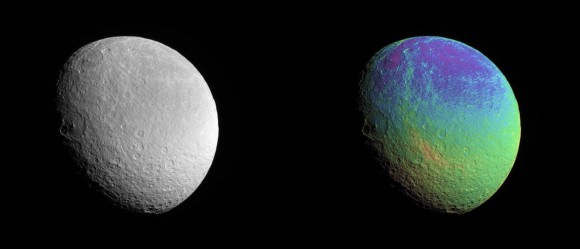
Titan:
As already noted, Titan is the largest of the Cronian moons. In fact, at 5,150 km in diameter, and 1,350×1020 kg in mass, Titan is Saturn’s largest moon and comprises more than 96% of the mass in orbit around the planet. Based on its bulk density of 1.88 g/cm3, Titan’s composition is half water ice and half rocky material – most likely differentiated into several layers with a 3,400 km rocky center surrounded by several layers of icy material.
It is also the only large moon to have its own atmosphere, which is cold, dense, and is the only nitrogen-rich dense atmosphere in the Solar System aside from Earth’s (with small amounts of methane). Scientists have also noted the presence of polycyclic aromatic hydrocarbons in the upper atmosphere, as well as methane ice crystals. Another thing Titan has in common with Earth, unlike every other moon and planet in the Solar System, is atmospheric pressure. On the surface of Titan, the air pressure is estimated to be around 1.469 bars (1.45 times that of Earth).
The surface of Titan, which is difficult to observe due to persistent atmospheric haze, shows only a few impact craters, evidence of cryovolcanoes, and longitudinal dune fields that were apparently shaped by tidal winds. Titan is also the only body in the Solar System beside Earth with bodies of liquid on its surface, in the form of methane–ethane lakes in Titan’s north and south polar regions.
With an orbital distance of 1,221,870 km, it is the second-farthest large moon from Saturn, and completes a single orbit every 16 days. Like Europa and Ganymede, it is believed that Titan has a subsurface ocean made of water mixed with ammonia, which can erupt to the surface of the moon and lead to cryovolcanism. The presence of this ocean, plus the prebiotic environment on Titan, has led some to suggest that life may exist there as well.
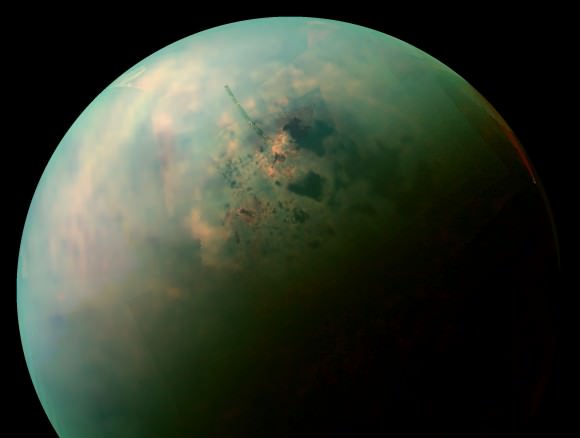
Such life could take the form of microbes and extremophiles in the interior ocean (similar to what is thought to exist on Enceladus and Europa), or could take the even more extreme form of methanogenic life forms. As has been suggested, life could exist in Titan’s lakes of liquid methane just as organisms on Earth live in water. Such organisms would inhale dihydrogen (H²) in place of oxygen gas (O²), metabolize it with acetylene instead of glucose, and then exhale methane instead of carbon dioxide.
However, NASA has gone on record as stating that these theories remain entirely hypothetical. So while the prebiotic conditions that are associated with organic chemistry exist on Titan, life itself may not. However, the existence of these conditions remains a subject of fascination among scientists. And since its atmosphere is thought to be analogous to Earth’s in the distant past, proponents of terraforming emphasize that Titan’s atmosphere could be converted in much the same way.
Beyond that, there are several reasons why Titan is a good candidate. For starters, it possess an abundance of all the elements necessary to support life (atmospheric nitrogen and methane), liquid methane, and liquid water and ammonia. Additionally, Titan has an atmospheric pressure one and a half times that of Earth, which means that the interior air pressure of landing craft and habitats could be set equal or close to the exterior pressure.
This would significantly reduce the difficulty and complexity of structural engineering for landing craft and habitats compared with low or zero pressure environments such as on the Moon, Mars, or the Asteroid Belt. The thick atmosphere also makes radiation a non-issue, unlike with other planets or Jupiter’s moons.
And while Titan’s atmosphere does contain flammable compounds, these only present a danger if they are mixed with sufficient enough oxygen – otherwise, combustion cannot be achieved or sustained. Finally, the very high ratio of atmospheric density to surface gravity also greatly reduces the wingspan needed for aircraft to maintain lift.
With all these things going for it, turning Titan into a livable world would be feasible given the right conditions. For starters, orbital mirrors could be used to direct more sunlight onto the surface. Combined with the moon’s already dense and greenhouse gas-rich atmosphere, this would lead to a considerable greenhouse effect that would melt the ice and release water vapor into the air.
Once again, this could be converted into a nitrogen/oxygen-rich mix, and more easily than with other Cronian moons since the atmosphere is already very rich in nitrogen. The presence of nitrogen, methane and ammonia could also be used to produce chemical fertilizers to grow food. However, the orbital mirrors would need to remain in place in order to ensure the environment did not become extremely cold again and revert to an icy state.
Iapetus:
At 1,470 km in diameter and 18×1020 kg in mass, Iapetus is the third-largest of Saturn’s large moons. And at a distance of 3,560,820 km from Saturn, it is the most distant of the large moons, and takes 79 days to complete a single orbit. Due to its unusual color and composition – its leading hemisphere is dark and black whereas its trailing hemisphere is much brighter – it is often called the “yin and yang” of Saturn’s moons.
With an average distance (semi major axis) of 3,560,820 km, Iapetus takes 79.32 days to complete an single orbit of Saturn. Despite being Saturn’s third-largest moon, Iapetus orbits much farther from Saturn than its next closest major satellite (Titan). Like many of Saturn’s moons – particularly Tethys, Mimas and Rhea – Iapetus has a low density (1.088 ± 0.013 g/cm³) which indicates that it is composed primary of water ice and only about 20% rock.
But unlike most of Saturn’s larger moons, its overall shape is neither spherical or ellipsoid, instead consisting of flattened poles and a bulging waistline. Its large and unusually high equatorial ridge also contributes to its disproportionate shape. Because of this, Iapetus is the largest known moon to not have achieved hydrostatic equilibrium. Though rounded in appearance, its bulging appearance disqualifies it from being classified as spherical.
Because of this, Iapetus is not a likely contender for terraforming. If in fact its surface were melted, it too would be an ocean world with unrealistically deep seas, and this water would likely be lost to space.
Potential Challenges:
To break it down, only Enceladus and Titan appear to be viable candidates for terraforming. However, in both cases, the process of turning them into habitable worlds where human beings could exist without the need for pressurized structures or protective suits would be a long and costly one. And much like terraforming the Jovian moons, the challenges can be broken down categorically:
- Distance
- Resources and Infrastructure
- Hazards
- Sustainability
- Ethical Considerations
In short, while Saturn may be abundant in resources and closer to Earth than either Uranus or Neptune, its really very far. On average, Saturn is approximately 1,429,240,400,000 kms away from Earth (or ~8.5 AU the equivalent of eight and a half times the average distance between the Earth and the Sun). To put that in perspective, it took the Voyager 1 probe roughly thirty-eight months to reach the Saturn system from Earth. For crewed spacecraft, carrying colonists and all the equipment needed to terraform the surface, it would take considerably longer to get there.

These ships, in order to avoid being overly large and expensive, would need to rely on cryogenics or hibernation-related technology in order to be smaller, faster and more cost-effective. While this sort of technology is being investigated for crewed missions to Mars, it is still very much in the research and development phase. What’s more, a large fleet of robotic spaceships and support craft would also be needed to build the orbital mirrors, capture asteroids or debris to use as impactors, and provide logistical support to crewed spaceships.
Unlike the crewed vessels, which could keep crews in stasis until their arrival, these ships would need to have advanced propulsion systems to ensure that they were able to make the trips to and from the Cronian moons in a realistic amount of time. All of this, in turn, raises the crucial issue of infrastructure. Basically, any fleet operating between Earth and Saturn would require a network of bases between here and there to keep them supplied and fueled.
So really, any plans to terraform Saturn’s moons would have to wait upon the creation of permanent bases on the Moon, Mars, the Asteroid Belt, and the Jovian moons. In addition, building orbital mirrors would require considerable amounts of minerals and other resources, many of which could be harvested from the Asteroid Belt or from Jupiter’s Trojans.
This process would be punitively expensive by current standards and (again) would require a fleet of ships with advanced drive systems. And paraterraforming using Shell Worlds would be no different, requiring multiple trips to and from the Asteroid Belt, hundreds (if not thousands) of construction and support craft, and all the necessary bases in between.
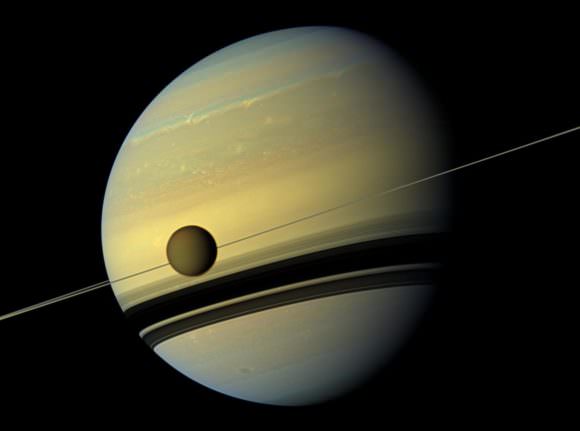
And while radiation is not a major threat in the Cronian system (unlike around Jupiter), the moons have been subject to a great deal of impacts over the course of their history. As a result, any settlements built on the surface would likely need additional protection in orbit, like a string of defensive satellites that could redirect comets and asteroids before they reached orbit.
Fourth, terraforming Saturn’s moons presents the same challenges as Jupiter’s. Namely, every moon that was terraformed would be an ocean planet And whereas most of Saturn’s moons are untenable due to their high concentrations of water ice, Titan and Enceladus are not that much better off. In fact, if all of Titan’s ice were melted, including the layer that is believed to sit beneath its interior ocean, its sea level would be up to 1700 km in depth!
Not only that, but this sea would surround a hydrous core, which would likely make the planet unstable. Enceladus would not fair any better, as gravity measurements by Cassini have shown that the density of the core is low, indicating that the core contains water in addition to silicates. So in addition to a deep ocean on its surface, its core might also be unstable.
And last, there are the ethical considerations. If both Enceladus and Titan are home to extra-terrestrial life, than any efforts to alter their environments could result in their destruction. Barring that, melting the surface ice could cause any indigenous life forms to proliferate and mutate, and exposure to them could prove to be a health hazard for human settlers.
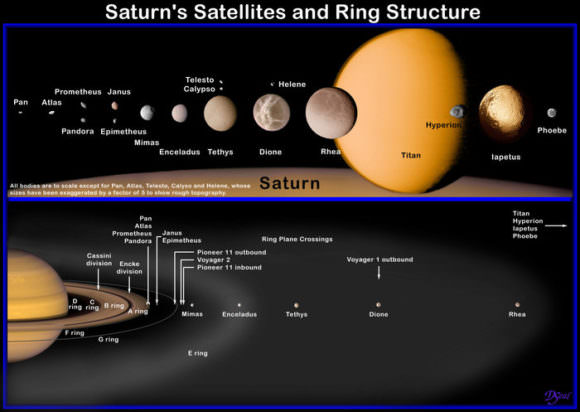
Conclusions:
Once again, when faced with all of these considerations, one is forced to ask, “why bother?” Why bother altering the natural environment of the Cronian moons when we could settle on them as is, and use their natural resources to usher in an age of post-scarcity? Quite literally, there is enough water ice, volatiles, hydrocarbons, organic molecules, and minerals in the Saturn system to keep humanity supplied indefinitely.
What’s more, without the effects of terraforming, settlements on Titan and Enceladus would probably be a lot more tenable. We could also fathom building settlements on the moons of Tethys, Dione, Rhea, and Iapetus as well, which would prove much more beneficial in terms of being able to harness the system’s resources.
And, as with Jupiter’s moons of Europa, Ganymede, and Callisto, foregoing the act of terraforming would mean there would be an abundant supply of resources that could be used to terraform other places – namely, Venus and Mars. As has been argued many times over, the abundance of methane, ammonia, and water ices in the Cronian system would be very useful in helping to turn “Earths twins” into “Earth-like” planets.
Once again, it would seem that the answer to the question “can/should we?” is a disappointing no.
We have written many interesting articles about terraforming here at Universe Today. Here’s The Definitive Guide To Terraforming, How Do We Terraform Mars?, How Do We Terraform Venus?, How Do We Terraform the Moon?, and How Do We Terraforming Jupiter’s Moons?
We’ve also got articles that explore the more radical side of terraforming, like Could We Terraform Jupiter?, Could We Terraform The Sun?, and Could We Terraform A Black Hole?
Astronomy Cast also has good episodes on the subject, like Episode 61: Saturn’s Moons.
For more information, check out NASA’s Solar System Exploration page on Saturn’s Moons and the Cassini mission page.
And if you like the video, come check out our Patreon page and find out how you can get these videos early while helping us bring you more great content!

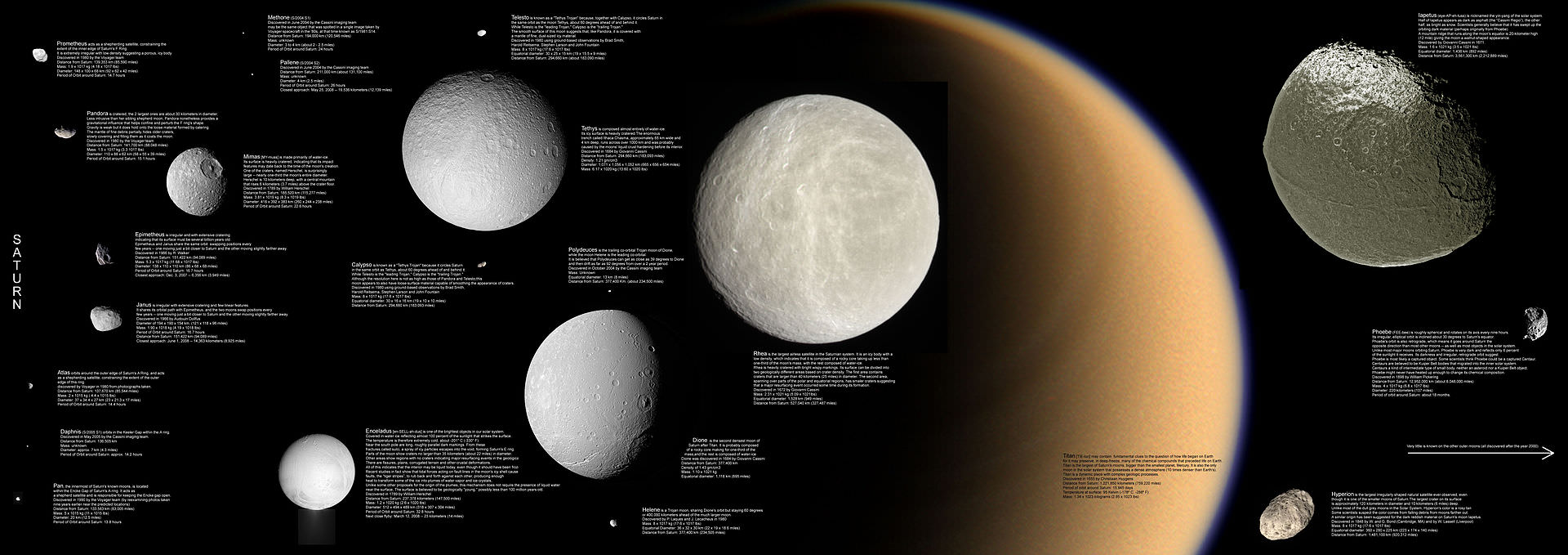
What about gravity? For humans to live long term on other planets/moons wouldn’t an Earth-like gravity also be necessary to terraforming a moon like Titan?
It’s always a factor. But in any act of terraforming, aside from Venus, there’s always reduced gravity to contend with. And what the long term effects of reduced gravity would be, we still don’t know
The smaller water based bodies, they could still have an average global temperature below freezing and still support life. That would keep the planet intact. A tundra planet if you like. Layers of soil could even be built up on top of the ice.
The smaller water based bodies, they could still have an average global temperature below freezing and still support life. That would keep the planet intact. A tundra planet if you like. Layers of soil could even be built up on top of the ice.